2002 MERCEDES-BENZ G500 engine
[x] Cancel search: enginePage 247 of 385
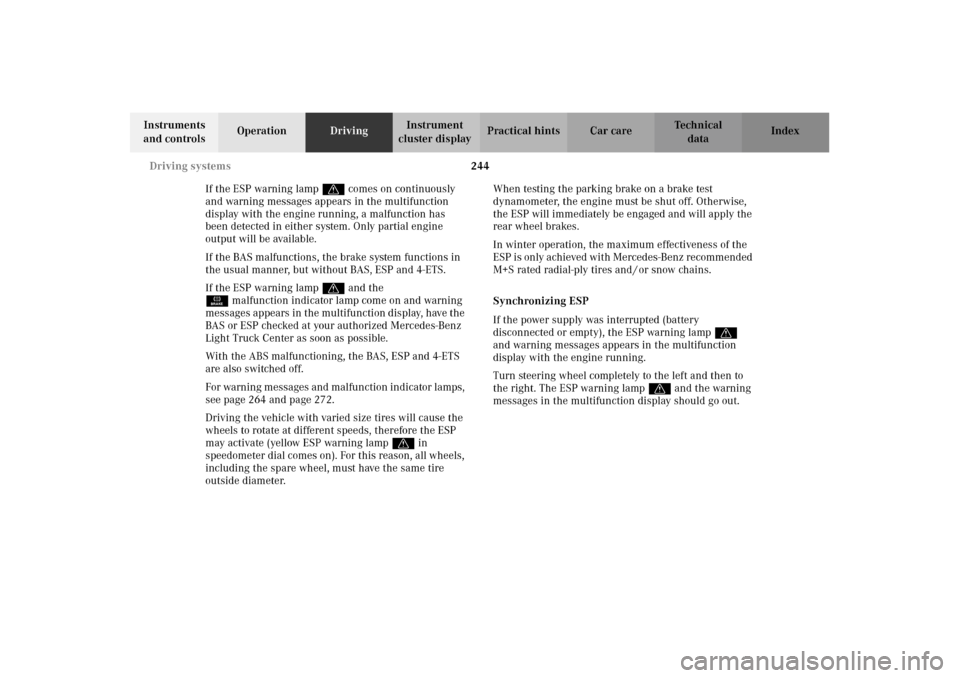
244 Driving systems
Te ch n i c a l
data Instruments
and controlsOperationDrivingInstrument
cluster displayPractical hints Car care Index
If the ESP warning lampv comes on continuously
and warning messages appears in the multifunction
display with the engine running, a malfunction has
been detected in either system. Only partial engine
output will be available.
If the BAS malfunctions, the brake system functions in
the usual manner, but without BAS, ESP and 4-ETS.
If the ESP warning lampv and the
Émalfunction indicator lamp come on and warning
messages appears in the multifunction display, have the
BAS or ESP checked at your authorized Mercedes-Benz
Light Truck Center as soon as possible.
With the ABS malfunctioning, the BAS, ESP and 4-ETS
are also switched off.
For warn in g m ess ages and malfun ction in d icator lamps ,
see page 264 and page 272.
Driving the vehicle with varied size tires will cause the
wheels to rotate at different speeds, therefore the ESP
may activate (yellow ESP warning lampv in
speedometer dial comes on). For this reason, all wheels,
including the spare wheel, must have the same tire
outside diameter.When testing the parking brake on a brake test
dynamometer, the engine must be shut off. Otherwise,
the ESP will immediately be engaged and will apply the
rear wheel brakes.
In winter operation, the maximum effectiveness of the
ESP is on ly achieved wit h Me rced es -B enz re comm end ed
M+S rated radial-ply tires and / or snow chains.
Synchronizing ESP
If the power supply was interrupted (battery
disconnected or empty), the ESP warning lampv
and warning messages appears in the multifunction
display with the engine running.
Turn steering wheel completely to the left and then to
the right. The ESP warning lampv and the warning
messages in the multifunction display should go out.
J_G463.book Seite 244 Mittwoch, 19. September 2001 8:06 08
Page 248 of 385
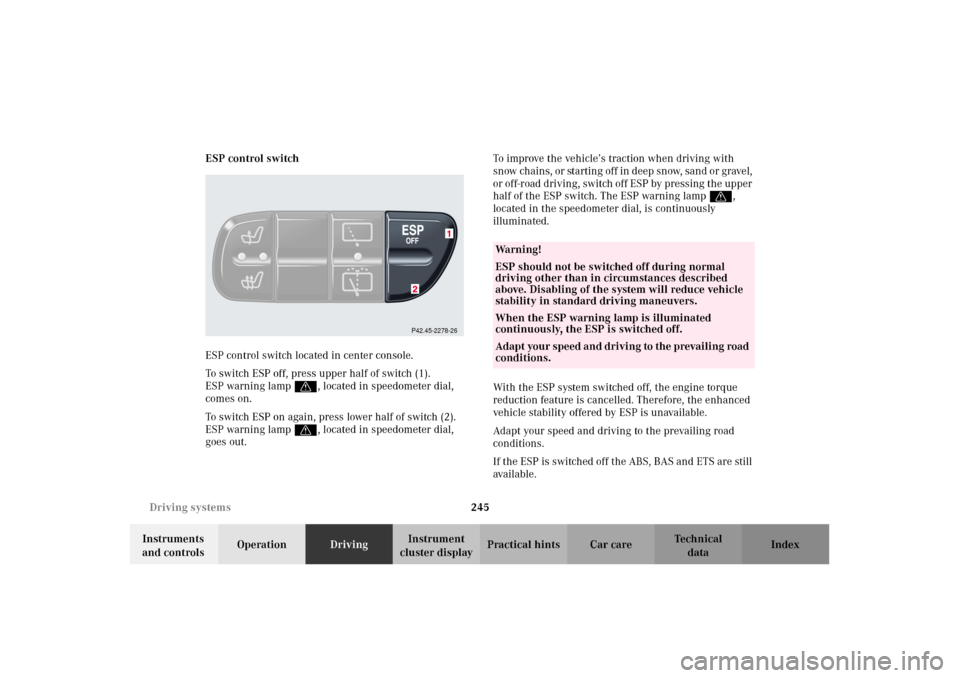
245 Driving systems
Te ch n i c a l
data Instruments
and controlsOperationDrivingInstrument
cluster displayPractical hints Car care Index ESP control switch
ESP control switch located in center console.
To switch ESP off, press upper half of switch (1).
ESP warning lamp v, located in speedometer dial,
comes on.
To switch ESP on again, press lower half of switch (2).
ESP warning lamp v, located in speedometer dial,
goes out.To improve the vehicle’s traction when driving with
sn ow chain s, or startin g of f in d eep sn ow, san d o r grave l,
or off-road driving, switch off ESP by pressing the upper
half of the ESP switch. The ESP warning lampv,
located in the speedometer dial, is continuously
illuminated.
With the ESP system switched off, the engine torque
reduction feature is cancelled. Therefore, the enhanced
vehicle stability offered by ESP is unavailable.
Adapt your speed and driving to the prevailing road
conditions.
If the ESP is switched off the ABS, BAS and ETS are still
ava il ab le .
P42.45-2278-26
Wa r n i n g !
ESP should not be switched off during normal
driving other than in circumstances described
above. Disabling of the system will reduce vehicle
stability in standard driving maneuvers.
When the ESP warning lamp is illuminated
continuously, the ESP is switched off.
Ad apt your s peed an d d ri vi n g to the prevai li ng road
conditions.
J_G463.book Seite 245 Mittwoch, 19. September 2001 8:06 08
Page 251 of 385
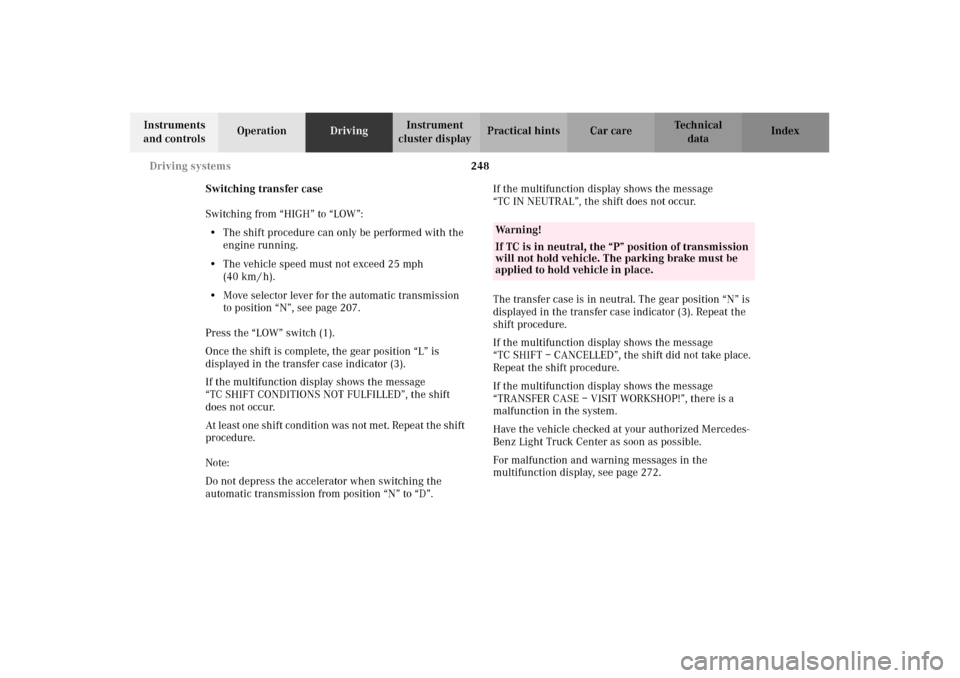
248 Driving systems
Te ch n i c a l
data Instruments
and controlsOperationDrivingInstrument
cluster displayPractical hints Car care Index
Switching transfer case
Switching from “HIGH” to “LOW”:
•The shift procedure can only be performed with the
engine running.
•The vehicle speed must not exceed 25 mph
(40 km / h).
•Move selector lever for the automatic transmission
to position “N”, see page 207.
Press the “LOW” switch (1).
Once the shift is complete, the gear position “L” is
displayed in the transfer case indicator (3).
If the multifunction display shows the message
“TC SHIFT CONDITIONS NOT FULFILLED”, the shift
does not occur.
At least one shif t con dition was n ot me t. Repe at t he shif t
procedure.
Note:
Do not depress the accelerator when switching the
automatic transmission from position “N” to “D”.If the multifunction display shows the message
“TC IN NEUTRAL”, the shift does not occur.
The transfer case is in neutral. The gear position “N” is
displayed in the transfer case indicator (3). Repeat the
shift procedure.
If the multifunction display shows the message
“TC SHIFT – CANCELLED”, the shift did not take place.
Repeat the shift procedure.
If the multifunction display shows the message
“TRANSFER CASE – VISIT WORKSHOP!”, there is a
malfunction in the system.
Have the vehicle checked at your authorized Mercedes-
Benz Light Truck Center as soon as possible.
For malfunction and warning messages in the
multifunction display, see page 272.
Wa r n i n g !
If TC is in neutral, the “P” position of transmission
will not hold vehicle. The parking brake must be
applied to hold vehicle in place.
J_G463.book Seite 248 Mittwoch, 19. September 2001 8:06 08
Page 252 of 385
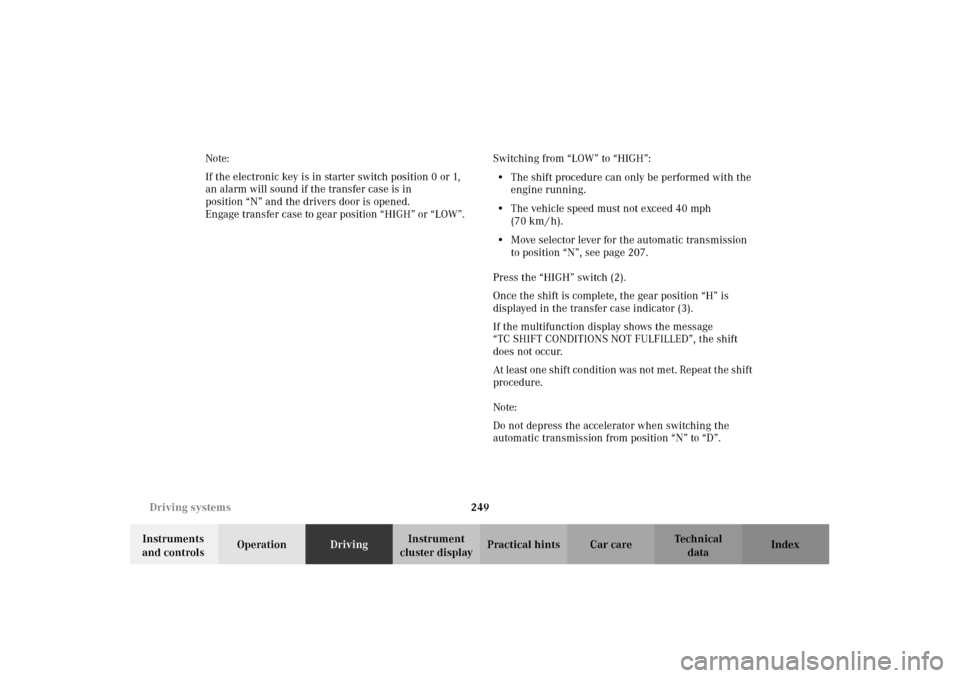
249 Driving systems
Te ch n i c a l
data Instruments
and controlsOperationDrivingInstrument
cluster displayPractical hints Car care Index Note:
If the electronic key is in starter switch position 0 or 1,
an alarm will sound if the transfer case is in
position “N” and the drivers door is opened.
Engage transfer case to gear position “HIGH” or “LOW”.Switching from “LOW” to “HIGH”:
•The shift procedure can only be performed with the
engine running.
•The vehicle speed must not exceed 40 mph
(70 km / h).
•Move selector lever for the automatic transmission
to position “N”, see page 207.
Press the “HIGH” switch (2).
Once the shift is complete, the gear position “H” is
displayed in the transfer case indicator (3).
If the multifunction display shows the message
“TC SHIFT CONDITIONS NOT FULFILLED”, the shift
does not occur.
At least on e s hif t co nd ition was not m et. Rep eat t he s hif t
procedure.
Note:
Do not depress the accelerator when switching the
automatic transmission from position “N” to “D”.
J_G463.book Seite 249 Mittwoch, 19. September 2001 8:06 08
Page 254 of 385
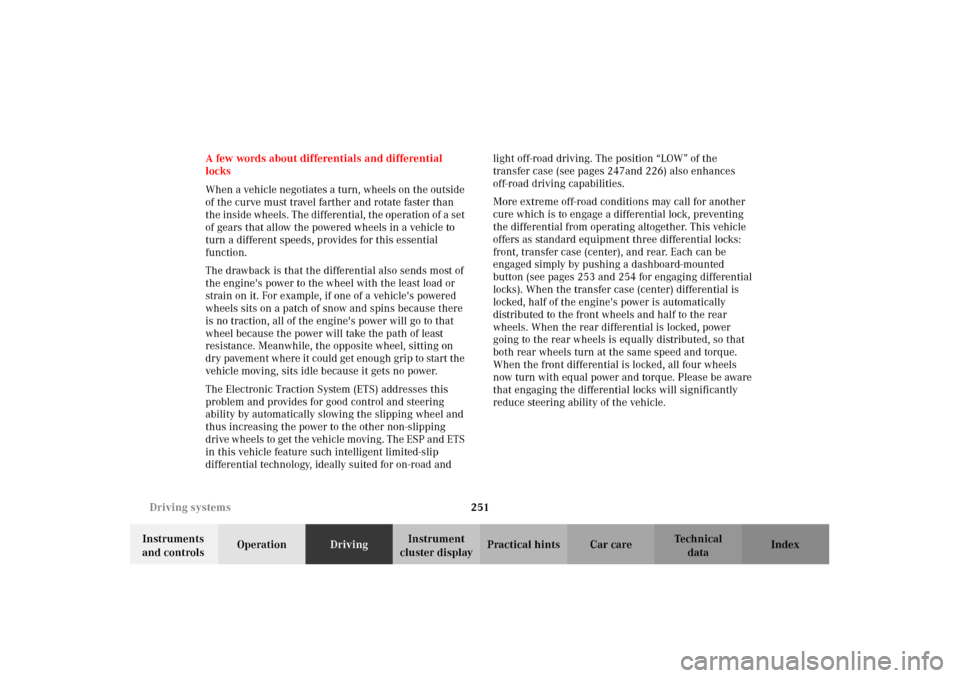
251 Driving systems
Te ch n i c a l
data Instruments
and controlsOperationDrivingInstrument
cluster displayPractical hints Car care Index A few words about differentials and differential
locks
When a vehicle negotiates a turn, wheels on the outside
of the curve must travel farther and rotate faster than
the inside wheels. The differential, the operation of a set
of gears that allow the powered wheels in a vehicle to
turn a different speeds, provides for this essential
function.
The drawback is that the differential also sends most of
the engine's power to the wheel with the least load or
strain on it. For example, if one of a vehicle's powered
wheels sits on a patch of snow and spins because there
is no traction, all of the engine's power will go to that
wheel because the power will take the path of least
resistance. Meanwhile, the opposite wheel, sitting on
dry pavement where it could get enough grip to start the
vehicle moving, sits idle because it gets no power.
The Electronic Traction System (ETS) addresses this
problem and provides for good control and steering
ability by automatically slowing the slipping wheel and
thus increasing the power to the other non-slipping
d rive whee ls to get t he ve hicle m ovin g. The ESP and ETS
in this vehicle feature such intelligent limited-slip
differential technology, ideally suited for on-road and light off-road driving. The position “LOW” of the
transfer case (see pages 247and 226) also enhances
off-road driving capabilities.
More extreme off-road conditions may call for another
cure which is to engage a differential lock, preventing
the differential from operating altogether. This vehicle
offers as standard equipment three differential locks:
front, transfer case (center), and rear. Each can be
engaged simply by pushing a dashboard-mounted
button (see pages 253 and 254 for engaging differential
locks). When the transfer case (center) differential is
locked, half of the engine's power is automatically
distributed to the front wheels and half to the rear
wheels. When the rear differential is locked, power
going to the rear wheels is equally distributed, so that
both rear wheels turn at the same speed and torque.
When the front differential is locked, all four wheels
now turn with equal power and torque. Please be aware
that engaging the differential locks will significantly
reduce steering ability of the vehicle.
J_G463.book Seite 251 Mittwoch, 19. September 2001 8:06 08
Page 262 of 385
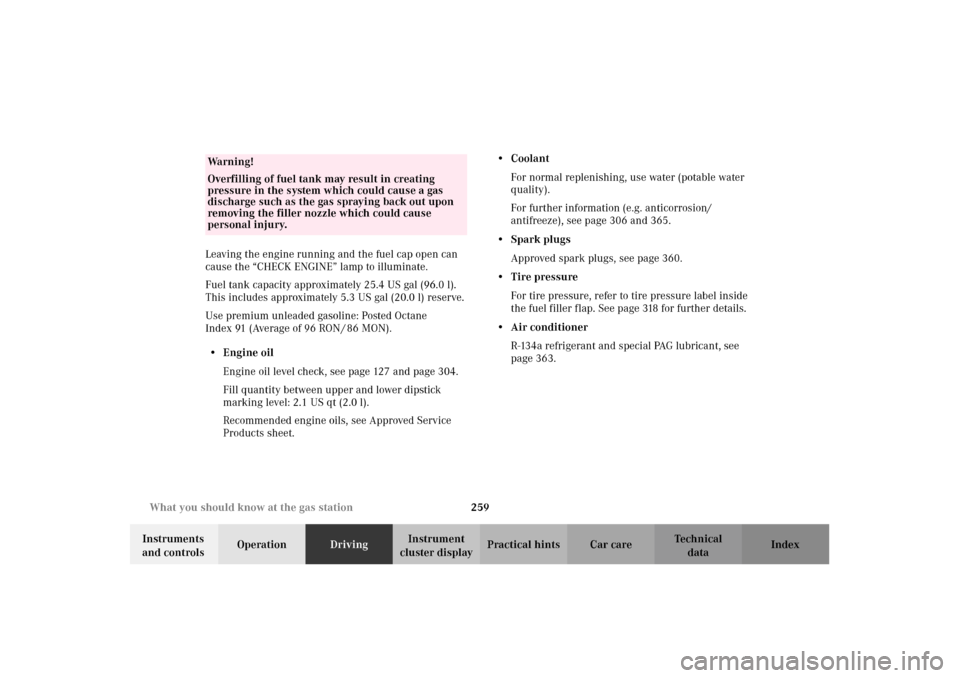
259 What you should know at the gas station
Te ch n i c a l
data Instruments
and controlsOperationDrivingInstrument
cluster displayPractical hints Car care Index Leaving the engine running and the fuel cap open can
cause the “CHECK ENGINE” lamp to illuminate.
Fuel tank capacity approximately 25.4 US gal (96.0 l).
This includes approximately 5.3 US gal (20.0 l) reserve.
Use premium unleaded gasoline: Posted Octane
Index 91 (Average of 96 RON / 86 MON).
•Engine oil
Engine oil level check, see page 127 and page 304.
Fill quantity between upper and lower dipstick
marking level: 2.1 US qt (2.0 l).
Recommended engine oils, see Approved Service
Products sheet.•Coolant
For normal replenishing, use water (potable water
quality).
For further information (e.g. anticorrosion/
antifreeze), see page 306 and 365.
• Spark plugs
Approved spark plugs, see page 360.
•Tire pressure
For tire pressure, refer to tire pressure label inside
the fuel filler flap. See page 318 for further details.
•Air conditioner
R-134a refrigerant and special PAG lubricant, see
page 363.
Wa r n i n g !
Overfilling of fuel tank may result in creating
pressure in the system which could cause a gas
discharge such as the gas spraying back out upon
removing the filler nozzle which could cause
personal injury.
J_G463.book Seite 259 Mittwoch, 19. September 2001 8:06 08
Page 264 of 385
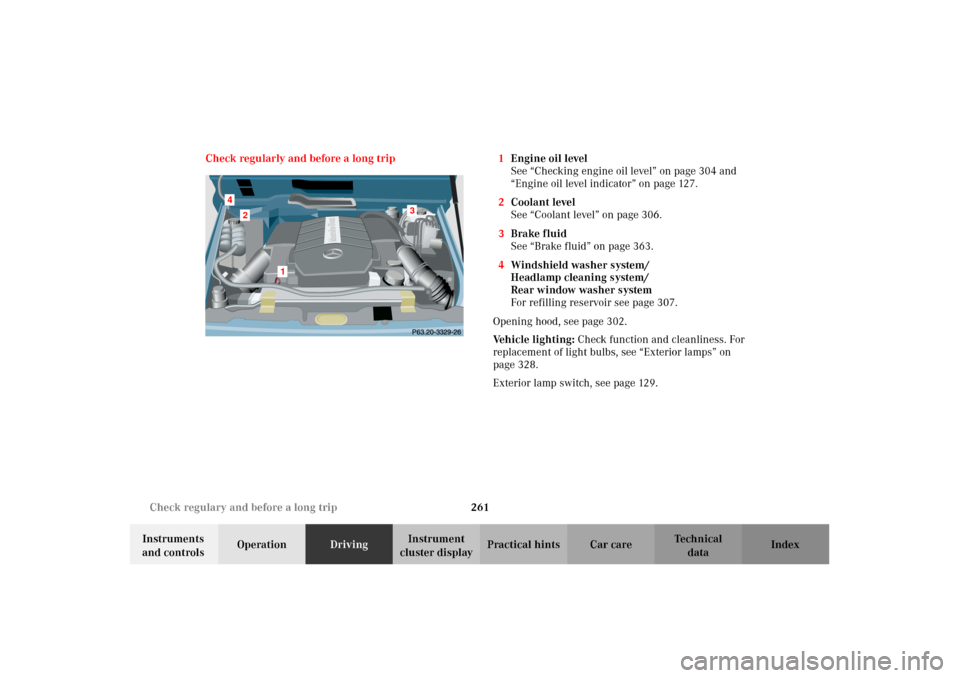
261 Check regulary and before a long trip
Te ch n i c a l
data Instruments
and controlsOperationDrivingInstrument
cluster displayPractical hints Car care Index Check regularly and before a long trip 1Engine oil level
See “Checking engine oil level” on page 304 and
“Engine oil level indicator” on page 127.
2Coolant level
See “Coolant level” on page 306.
3Brake fluid
See “Brake fluid” on page 363.
4Windshield washer system/
Headlamp cleaning system/
Rear window washer system
For refilling reservoir see page 307.
Opening hood, see page 302.
Vehicle lighting: Check function and cleanliness. For
replacement of light bulbs, see “Exterior lamps” on
page 328.
Exterior lamp switch, see page 129.
2
1
3
4
J_G463.book Seite 261 Mittwoch, 19. September 2001 8:06 08
Page 266 of 385
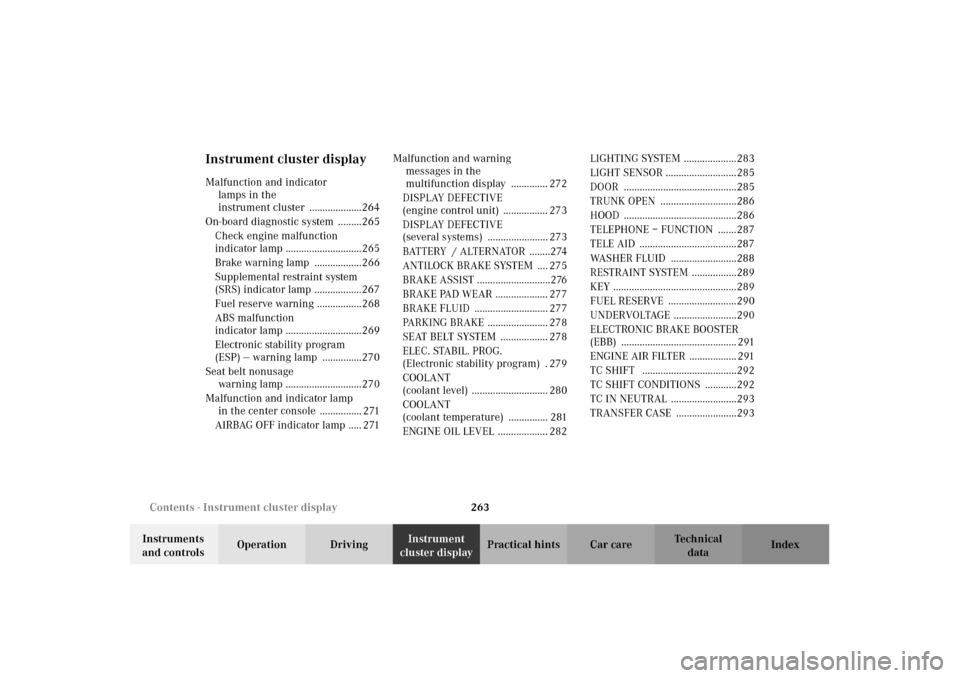
263 Contents - Instrument cluster display
Te ch n i c a l
data Instruments
and controlsOperation DrivingInstrument
cluster displayPractical hints Car care Index
Instrument cluster displayMalfunction and indicator
lamps in the
instrument cluster ....................264
On-board diagnostic system .........265
Check engine malfunction
indicator lamp .............................265
Brake warning lamp ..................266
Supplemental restraint system
(SRS) indicator lamp ..................267
Fuel reserve warning .................268
ABS malfunction
indicator lamp .............................269
Electronic stability program
(ESP) — warning lamp ...............270
Seat belt nonusage
warning lamp .............................270
Malfunction and indicator lamp
in the center console ................ 271
AIRBAG OFF indicator lamp ..... 271Malfunction and warning
messages in the
multifunction display .............. 272
DISPLAY DEFECTIVE
(engine control unit) ................. 273
DISPLAY DEFECTIVE
(several systems) ....................... 273
BATTERY / ALTERNATOR ........274
ANTILOCK BRAKE SYSTEM .... 275
BRAKE ASSIST ............................276
BRAKE PAD WEAR .................... 277
BRAKE FLUID ............................ 277
PARKING BRAKE ....................... 278
SEAT BELT SYSTEM .................. 278
ELEC. STABIL. PROG.
(Electronic stability program) . 279
COOLANT
(coolant level) ............................. 280
COOLANT
(coolant temperature) ............... 281
ENGINE OIL LEVEL ................... 282LIGHTING SYSTEM ....................283
LIGHT SENSOR ...........................285
DOOR ...........................................285
TRUNK OPEN .............................286
HOOD ...........................................286
TELEPHONE – FUNCTION .......287
TELE AID .....................................287
WASHER FLUID .........................288
RESTRAINT SYSTEM .................289
KEY ...............................................289
FUEL RESERVE ..........................290
UNDERVOLTAGE ........................290
ELECTRONIC BRAKE BOOSTER
(EBB) ............................................ 291
ENGINE AIR FILTER .................. 291
TC SHIFT ....................................292
TC SHIFT CONDITIONS ............292
TC IN NEUTRAL .........................293
TRANSFER CASE .......................293
J_G463.book Seite 263 Mittwoch, 19. September 2001 8:06 08